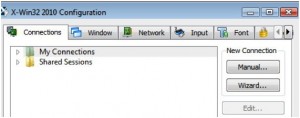Getting on the super (computer) highway
Hurray, you! You read my last post and now have your data on the high performance computing cluster wherever it is that people were silly enough to give someone like you access.
You have an account. You have data. Now what?
Oh, yeah, you need to connect to your host computer and do stuff.
If you have a Mac …
A) It came with X11. You may have installed it when you installed your OS. (I’m running Snow Leopard and that’s what I did.) If not,
B) according to the forum on dealmac
“Open the Optional Installs folder on the Snow Leopard DVD and run the Optional Installs.mpkg installer.”
I think they’re probably not lying. You should try that.
If you’re not sure if you have X11 installed:
- Look in your dock. See if you see a white square with a big grey X. That’s it. Click on that.
- If it’s not in your dock, open your applications folder and look in your UTILITIES folder. You should see something named X11. If so, click on that.
- If neither of the above, look in the same UTILITIES folder and see if you see something named Terminal. Click on it.
- If none of the above work, go back to B above !
If you have Linux ….
If you were paying attention to the last post, you would know that you can find Terminal under the APPLICATIONS menu under ACCESSORIES in Ubuntu.
Once you have X11 (or Terminal) open, type
ssh -Y username@hostcomputer
like
ssh -Y annmaria@hpcc.myu.edu
If you forget the -Y, you’ll still be able to do command line commands but anything that requires using windows, like opening up SAS interactively and using the program editor window, using emacs, etc. will give you nasty error messages and you will wish you had paid more attention to me. (As I always tell my children about life in general.)
If you have Windows …
On Windows, I use X-Win32 simply because it is very easy to use and you can download a free 30-day trial if your institution does not have a site license.
- Download and install X-Win32
- From the START menu, select ALL PROGRAMS then INTERNET TOOLS then X-WIN32 and, finally, under that, select X-CONFIG
The window below will pop-up

3. Select WIZARD and click OK
4. Give your connection a name, like hpcc
5. There will be four types of connections to choose from. Click on SSH and click NEXT
6. You will be asked for a host name to connect to. This is the name of the high performance computing installation at your organization. It will be something like hpc.myu.edu . Fill in the host name and click NEXT.
7. You will be asked for your user name and password. Enter that information.
8. The final window asks you for a command. This is the point where you wonder what the heck you are supposed to put. It also has a window underneath where you can click on a number of choices such as Linux, Solaris, etc. Select Linux. For command, type:
/usr/bin/xterm –ls
(This command will start a terminal emulator. The –ls specifies that the shell started in the xterm window will be a login shell.)
9. Click FINISH
10. The new connection name should show up in your window under Shared Sessions. Click OK.
You only need to do the steps above once. Now you have configured your session, in the future you can just X-Win32 from the START menu. When you double-click on it, the window will appear showing all of your sessions. Click on the hpcc session and click the LAUNCH button. A window appears that looks like the one below. You are now connected.
 Yes, yes it is very much more complicated with Windows.
Yes, yes it is very much more complicated with Windows.
And this surprises you, why?
OH! Very annoying thing …. if you click on XWIN32 from the start menu and you don’t see anything, for some weirdo bizarre reason sometimes it just decides to hang out at the bottom right of your screen. Look at the bottom right of your screen for a blue box with an X in it. Click on that and it should open up the window you need.
You can now type in Linux commands – if you know any.
One Comment